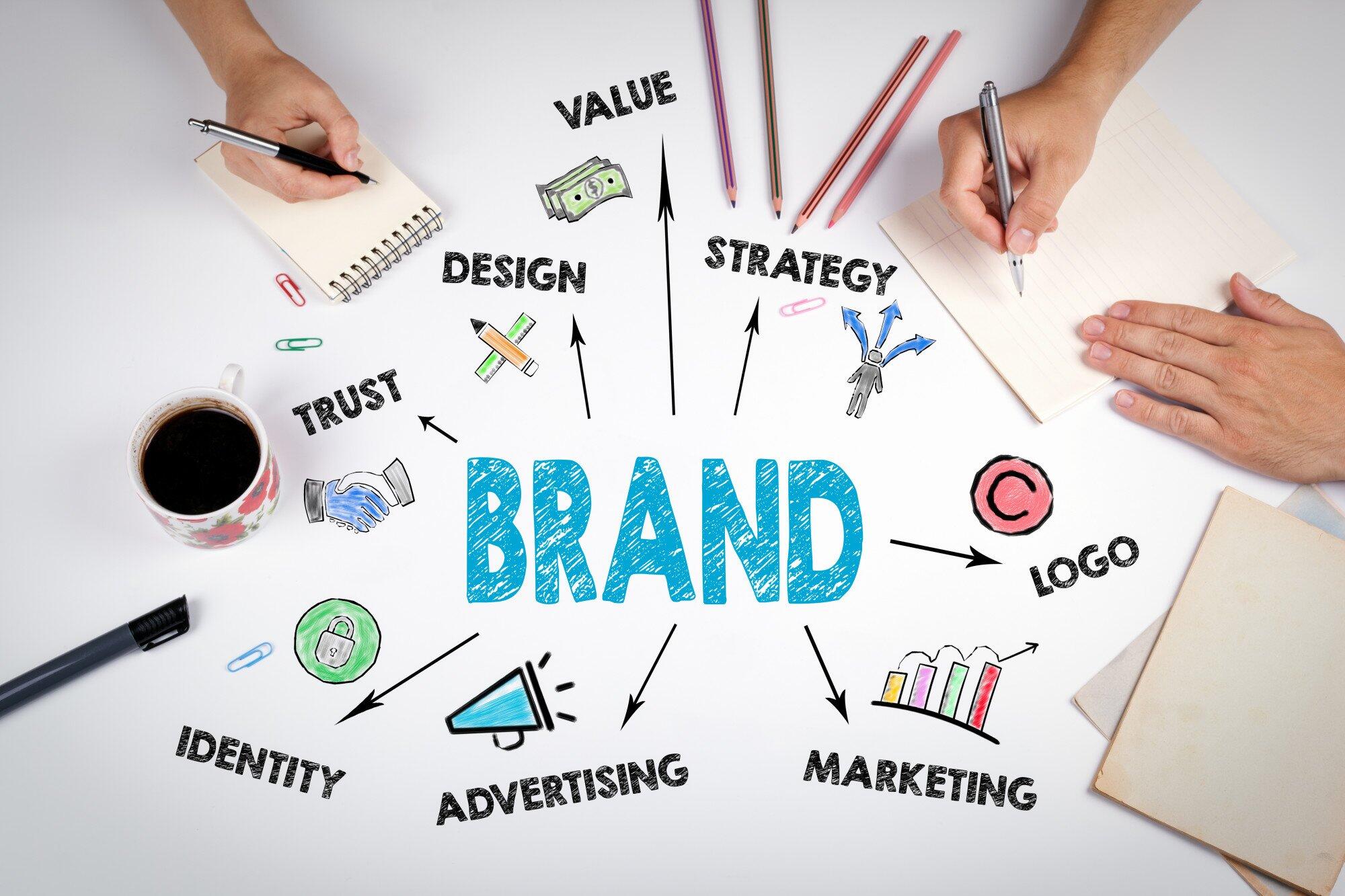The Power of Visual Branding: Elevating Your Business With Brand Identity Design Services
Posted on April 05, 2024 by Logo Design Tips and Tricks

In the bustling marketplace of today, snagging the spotlight for your business isn’t just a matter of having a great product or service. It’s also about how captivatingly you can present your brand to the world. That’s where the magic of visual branding steps in!
Imagine walking down a street lined with shops. It’s the ones with the most attractive signs and displays that catch your eye, isn’t it? This is exactly how effective visual branding works! It makes your business the one that people can’t help but notice.
So let’s delve into the world of brand identity design services.
First Impressions Count
You only get one shot at a first impression, and in today’s fast-paced world, it often hinges on your visual branding. This includes everything from your logo to your website design and even your social media graphics.
A professional and cohesive visual identity can project your brand as trustworthy and high-quality right off the bat. On the other hand, if your visual branding is inconsistent or unappealing, it can leave potential customers with a negative impression and steer them away from your business.
Creates Brand Recognition
Visual branding helps create a unique identity for your business. This sets you apart from competitors. Using specific colors, fonts, and design elements in all your marketing materials can create a visual representation of your brand.
With this, customers can easily recognize and associate with your products or services. This also helps build brand loyalty and trust. Customers are more likely to choose a brand they are familiar with and have positive associations with.
Storytelling Through Design
Every brand has a story, and visual branding is your chance to tell it without words. Through colors, fonts, and imagery, you can convey your business’s personality and values. By strategically using design elements, you can create a visual narrative that resonates with your target audience.
Professional graphic designers have the expertise to translate the essence of your brand into a visual language. They can create a memorable logo to design impactful marketing materials. They also ensure every piece of visual content aligns with your brand identity and tells your story effectively.
Leveraging graphic design services can elevate your brand’s perception. Making it recognized, remembered, and preferred among the myriad of options available in the market.
Keeping up With Trends
Visual branding is not a one-time task but an ongoing process. Trends and consumer preferences change. So, it’s essential to keep your visual identity updated to stay relevant and appeal to your target audience.
By reviewing and refreshing your visual branding, you can ensure that your business stays in tune with the market and stands out among competitors.
Elevating Your Business With Brand Identity Design Services
Investing in professional brand identity design services can elevate your business from just being another option to being the preferred choice. It’s not just about looking good. It’s about creating a visual language that speaks directly to your target audience.
This can build trust and distinguish your business in the global marketplace. Visual branding isn’t just a first step. It’s a continuous investment in how the world sees your business. Don’t underestimate the power of visual branding and make sure to prioritize it in your marketing strategy.
Did you find this article helpful? Check out the rest of our blogs!
Staying Ahead of the Curve: How a Dental Practice Consultant Help You Thrive
Posted on April 05, 2024 by Logo Design Tips and Tricks

Running a dental practice isn’t just about fixing teeth; it’s about running a whole business. There’s a lot to handle, like managing a team, making sure everything runs smoothly, and keeping patients coming back.
That’s where a dental practice consultant comes in. But what exactly does this specialist do, and how can they help dental professionals not only survive but positively thrive in a competitive market?
Join us in exploring the invaluable support dental consultants can offer to bring your practice to the next level. Read on!
Strategic Planning for Success
The first thing a dental consultant does is check how things are going for you. They look at who your patients are, what your money situation is, and what the market is like where you are.
This helps them make a plan for you that targets what you want soon and later on. They might also find ways for you to make your services better or grow your business.
Optimizing Patient Experience
Turning a dental practice into one that really focuses on what patients need and want is the way things are going. A dental consultant helps make things work smoother, like making it quicker for patients to get started, not having to wait as long, and generally making patients happier. They know about cool new tools that can help figure out what’s wrong and fix it better, making visits nicer and more helpful for everyone.
Harnessing Digital Marketing
In our digital age, being seen online is super important. Dental management consultants, who know a lot about running digital marketing campaigns can help you make a good online plan to get and keep patients. They can help you make a website that’s easy to use, help you be active and interesting on social media, and teach you about dental SEO (search engine optimization).
Training and Development
Always learning and getting better is important to do well in any job. Outsourcing a dental consultant from companies like www.2740consulting.com can plan and run training for your team.
This helps everyone stay up-to-date with new dental methods, how to help customers better, and the latest tech. This way, everyone works together well, aiming to meet the goals and values of your dental office.
Financial Management and Efficiency
Dental consultants help your dental office make more money and spend less. They check how you earn and spend to find what can be better.
Following their advice means you can manage money better, bill patients better, and make more money. They help you use your money well so you can buy new technology or make patients happier.
The Proactive Approach
Bringing in a dental consultant is like getting a helper before things go wrong. It’s a smart way to do performance analysis and stop problems before they happen.
They know a lot about dental businesses and can give advice that’s not biased. This means they can help make your business run smoother, so you can concentrate on taking great care of your patients’ teeth.
The Indispensable Role of a Dental Practice Consultant
A dental practice consultant can make the difference between just surviving and really thriving for dental practices that want to do well in a competitive market. These people are very helpful if you want to keep your dental practice going strong.
They can give you strategic advice, set up systems that are easy for patients to use, and keep up with the latest trends in digital marketing. Don’t forget that a business that plans for the future is good.
Did you like this guide? Great! Please browse our website for more!
How a Trusted Commercial Carpet Cleaner Can Save You Time and Money
Posted on April 05, 2024 by Logo Design Tips and Tricks

As a business owner, maintaining a clean and professional image is crucial for your company’s success. One aspect that plays a major role in this is the cleanliness of your commercial space. Particularly your carpets.
Carpets add to the aesthetic appeal of your office. They also provide comfort and contribute to the ambiance.
But, with regular foot traffic and spills, carpets can become dirty and stained. Thus, making it difficult to maintain a clean and professional environment. This is where a trusted commercial carpet cleaner comes in.
Time-Saving Benefits
Hiring a professional carpet cleaning company in your local area like Puyallup Carpet Cleaning Pros can save you time and effort. As a business owner, your time is valuable. Spending hours trying to deep clean your carpets yourself can be a major inconvenience.
A professional commercial carpet cleaner has the equipment, expertise, and techniques needed to efficiently and effectively clean your carpets. Thus, allowing you to focus on other important tasks for your business.
Cost-Saving Benefits
Some business owners might be hesitant to hire a carpet cleaning service because of how much it costs. But, hiring a trusted commercial carpet cleaner can save you money in the long run.
Cleaning your rugs regularly can help them last longer. This keeps you from having to buy new ones too soon, which saves you money.
Professional carpet cleaners also use high-quality products and methods that not only clean your rugs but also protect them and keep them in good shape. This means you won’t have to spend extra money on replacing or fixing your carpet, which can be pricey.
Health and Safety Benefits
Dirty carpets can harbor allergens, bacteria, and other harmful substances that can affect your employees’ and customers’ health and safety. Regular carpet cleaning by a trusted commercial cleaner eliminates these risks. Thus, creating a healthier and safer environment for all.
Professional cleaners also use safe and eco-friendly cleaning products. Green carpet cleaning ensures a healthy and safe environment for everyone in your commercial space. This can lead to better employee productivity and customer satisfaction.
Reputation and Image Benefits
Any business needs to make a good first impression. Customers and clients will have a good opinion of your business if they walk into a clean, well-kept office.
Meanwhile, dirty carpets can give off the impression of unprofessionalism and lack of attention to detail. When you hire a carpet cleaning company regularly, you can keep your business looking clean and professional.
Prevention of Damage and Discoloration
Commercial carpets are usually made of strong materials that can handle a lot of foot traffic. But if you don’t take care of them, they can get damaged or discolored over time.
A professional carpet cleaner knows how to clean and treat different types of carpets in the right way. This helps prevent damage and discoloration.
Regular vacuuming and deep cleaning also remove rough dirt particles that can wear down your carpets. Thus, making them last longer.
Prevention of Mold and Mildew Growth
High levels of moisture and humidity can cause mold and mildew growth in carpets. This not only creates an unpleasant smell but also poses health risks.
A reputable commercial carpet cleaner has the equipment and expertise to dry your carpets after cleaning. Thus, preventing mold and mildew growth. This helps maintain a clean and healthy environment for your business.
Customized Maintenance Plans
Each business is different, and each one has different carpet cleaning needs. You can trust a reliable commercial carpet cleaner to help you make a maintenance plan that fits your needs.
They offer flexible scheduling choices so that they don’t get in the way of your business too much. For example, they can work around your schedule to clean during times that aren’t as busy. This ensures minimal downtime and maximizes productivity.
Insurance Coverage
Accidents can happen during the cleaning process. This includes damage to your carpets or property.
In these cases, a professional carpet cleaner with insurance coverage will take responsibility and cover any damages. This gives business owners peace of mind and protects their investment.
Preservation of Property Value
Clean, well-maintained carpets contribute to the value of your commercial property. Regular professional cleaning helps preserve the appearance and condition of your carpets.
This can be advantageous if you decide to sell or lease your property in the future. Maintaining the property’s value can save you money. It attracts higher-quality tenants or commands a better selling price.
Compliance with Industry Standards
When you hire a reputable commercial carpet cleaner, you’re following best practices and industry standards. This keeps your space clean and shows that you care about making sure your workers and customers are safe and healthy.
It also helps you avoid potential fines or penalties for not meeting industry standards. Thus, ensuring the smooth operation of your business.
Long-Term Relationships
Working with a trusted commercial carpet cleaner can lead to long-term relationships and partnerships. As they get to know your business and its specific needs, they can provide tailored services that meet your evolving requirements.
Moreover, these professional relationships can also extend beyond carpet cleaning. Some companies offer additional services.
This includes upholstery cleaning, tile and grout cleaning, and water damage restoration. This makes it convenient to have all your cleaning needs taken care of by one reliable company.
Peace of Mind
Hiring a professional commercial carpet cleaner gives you peace of mind. You can trust that they will be cleaned, maintained, and protected, without worrying about potential damage or health hazards. This allows you to focus on other aspects of your business, knowing that your carpets are being taken care of.
Hire a Commercial Carpet Cleaner Now!
A trusted commercial carpet cleaner can provide many benefits for business owners. From time and cost-saving advantages to maintaining a professional image and preserving property value, regular professional cleaning is an investment that yields long-term returns. So why wait? Schedule your next commercial carpet cleaning service today and experience the difference it can make for your business. Happy cleaning!
Is this article helpful? Keep reading our blog for more.
Reasons Why Professional Dryer Vent Cleaning is Essential for Every Home
Posted on April 05, 2024 by Logo Design Tips and Tricks

You may not think about it often, but your laundry room harbors a silent threat — a clogged dryer vent.
Neglecting this vital home maintenance task could lead to dire consequences. This can include house fires, increased utility bills, and even health concerns. This comprehensive guide underscores the critical reasons why professional dryer vent cleaning is an essential service that can’t be overlooked.
So, read on to understand why this often overlooked task is crucial for the safety and efficiency of your home.
Let’s begin!
Prevention of Fire Hazards
Dryer vent cleaning is a crucial task that helps prevent fire hazards in your home. When lint builds up in the dryer vent, it restricts airflow and causes the dryer to overheat. This can lead to fires, which can spread quickly and cause significant damage to your home and belongings.
Fire hazards can also occur if the exhaust vent is not connected correctly or becomes damaged. This can cause hot air and lint to escape into your home’s walls. This helps by increasing the risk of fire.
By regularly cleaning and maintaining your dryer vent, you can prevent these potential fire hazards and keep your home safe. Fire prevention is an essential aspect of home maintenance. So, a dryer vent cleaning should be a part of your routine.
Improvement of Dryer Efficiency
Another essential reason to get your dryer vent cleaned is to improve its efficiency. When the vent is clogged with lint and debris, it puts a strain on your dryer’s performance. As a result, it takes longer for your clothes to dry, which can lead to increased energy bills.
Regular dryer vent cleaning removes all the accumulated lint and debris, allowing air to flow freely. This not only reduces the time required to dry your clothes but also decreases your energy consumption. This can save you money in the long run.
Extension of Dryer Lifespan
Cleaning your dryer vent regularly can also help extend the lifespan of your appliance. When lint and debris accumulate in the vent, it creates a blockage that forces your dryer to work harder and run longer cycles.
This added strain on the machine can cause it to break down faster. This can lead to costly repairs or even replacement. By keeping your dryer vent clean, you reduce its workload and ensure that it operates efficiently. Thus, ultimately extending its lifespan.
Prevention of Carbon Monoxide Exposure
Another often overlooked but critical reason for regular dryer vent cleaning is to prevent carbon monoxide exposure. The exhaust from your dryer can contain this odorless and colorless gas. This can be dangerous to inhale.
If the vent is clogged, the carbon monoxide can back up into your home instead of being directed outside. This poses a serious health risk to you and your family. By cleaning your dryer vent regularly, you can ensure that the gas is safely released outside and not trapped inside your home.
Elimination of Mold and Mildew Growth
Clogged dryer vents can also become a breeding ground for mold and mildew. When the vent is blocked, moisture cannot escape. This creates a humid environment perfect for these fungal growths.
Mold and mildew not only cause unpleasant odors but can also pose health risks to those living in your home. This is especially true for those with respiratory issues.
Regular dryer vent cleaning prevents this moisture build-up and eliminates the potential for mold and mildew growth. Thus, keeping your home clean and healthy.
Reduction of Allergens and Indoor Air Pollution
The accumulation of lint and debris in your dryer vent can also impact the indoor air quality. These particles can be released into the air and circulate throughout your living space, causing allergies and respiratory issues for you and your family.
By regularly cleaning your dryer vent, you can reduce the number of allergens and pollutants circulating in your home’s air, creating a healthier living environment for everyone.
Compliance with Manufacturer Warranty Requirements
Regular dryer vent cleaning is necessary to comply with your appliance’s manufacturer warranty requirements. Most manufacturers recommend annual or bi-annual cleaning to ensure the proper functioning of the dryer and maintain its warranty coverage.
By neglecting this maintenance task, you risk voiding your warranty and incurring additional costs for repairs or replacements. This is why it’s crucial to schedule regular dryer vent cleaning and keep a record of it for warranty purposes.
Prevention of Structural Damage
Clogged dryer vents can also cause structural damage to your home. When the hot air and moisture are pushed back into your walls, it can lead to mold growth, warping of wood, and even rotting of the structure.
These issues not only compromise the integrity of your home but also require expensive repairs. Regularly cleaning your dryer vent can prevent this damage and ultimately save you money on costly home repairs.
Enhancement of Home Safety and Peace of Mind
Regular dryer vent cleaning provides an overall enhancement of home safety and peace of mind. By ensuring that your dryer is functioning correctly and not posing any potential hazards, you can rest easy knowing that your home and family are safe.
Professional dryer vent cleaning also includes a thorough inspection of the entire system, identifying any potential issues before they become major problems. This proactive approach to home maintenance can give you peace of mind, knowing that your dryer vent is in good condition and not a threat to your safety.
Cost Savings in the Long Run
While it may seem like an added expense, regular dryer vent cleaning can save you money in the long run. By preventing fire hazards, improving efficiency, extending the lifespan of your dryer, and avoiding costly repairs or replacements, this essential maintenance task pays off in cost savings over time.
Moreover, professional dryer vent cleaning services typically offer competitive pricing and discounts. This makes it an affordable investment for the safety and efficiency of your home. With a duct cleaning service and maintenance plan, you can ensure that your dryer vent is regularly cleaned and maintained at a reasonable cost.
Professional Dryer Vent Cleaning is Essential
Regular dryer vent cleaning is an essential home maintenance task that offers a multitude of benefits. Neglecting this task is not an option.
By scheduling professional dryer vent cleaning, you can rest assured that your home is in good hands. Experienced technicians will use specialized tools and techniques to thoroughly clean your dryer vent, ensuring its safety, efficiency, and longevity.
Should you wish to explore other posts, feel free to visit our main blog page. We’ve got more!








